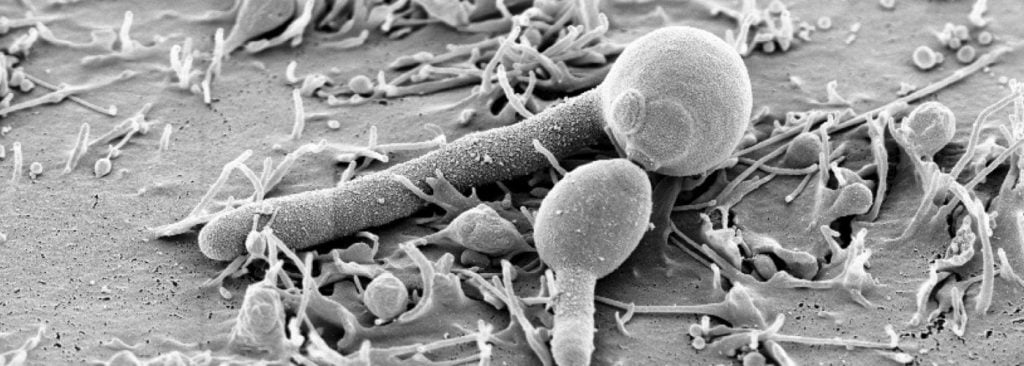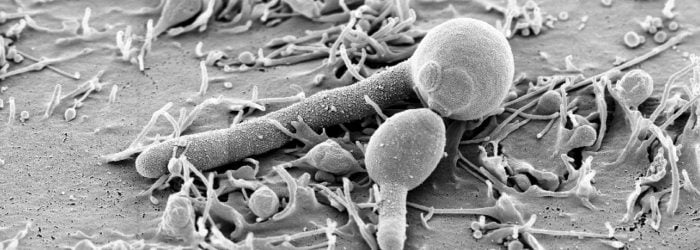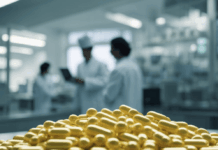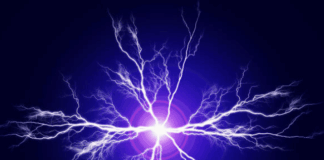
By
Most people living in modern societies suffer from an excess of Candida. Like bacteria, we all have fungi cohabiting within us. Anyone who is chronically ill is dealing with an abundance of Candida. While more and more people are beginning to realize this, most of the protocols and supplements sold to repair gut function and balance flora are not getting people well. We will address the reasons for this, but first let’s get a better understanding of what Candida is, and why we at OLM keep harping on it as if this microbe is the foundation for all disease.
Candida, Yeast, Mold, Fungus, 101
Yeast is a fungus that grows as a single cell. They look like translucent crisped rice cereal under a microscope. Mold is fungus that grows in multicellular filaments called hyphae. Fungi is the plural form of fungus, so, for instance, if we’re talking about Candida albicans we call it a fungus. If we’re talking about more than one specific kind, it’s fungi.
Candida is a genus of yeasts. There are nearly 20 different strains with different qualities peculiar to each species that we know of. Candida is the most common cause of fungal infections worldwide. Many different species of Candida are found in our gut flora, most commonly the C. albicans. Other fungi are also found in our gut. Any protocol that addresses Candida properly addresses all fungal overgrowth. Though they mean different things, often times within medicine the words Candida, fungus, and yeast are used interchangeably. Mold, on the other hand, is not generally used synonymously with the latter. Generally, when health practitioners speak of mold, they are referring to environmental exposure, like from a moldy home, for instance.
Black mold and other mold exposure should also be treated by an anti-fungal protocol. Black molds and other molds do not directly cause Candida overgrowth, but anything that depletes the immune system for a long enough period of time will lead to Candida overgrowth.
Candida albicans
Candida albicans is a polymorphic fungus. This means that it can grow in several different forms. When the gut is good and healthy, there will most likely be some Candida in the form of yeast (the little rice crispy looking fellows). Candida is usually a commensal, or symbiotic, organism but can become pathogenic when it becomes filamentous. Other types of Candida we are familiar with so far that can cause infection in humans include Candida tropicalis, Candida glabrata, Candida parapsilosis, Candida krusei, Candida lusitaniae, and Candida auris. For these intents and purposes, we’ll just be referring to any overgrowth of Candida, which will address all fungal infection.
Candida albicans is found in over 70% of the population, and due to inaccuracies of testing, this percentage is likely much higher. If we include all kinds of Candida, one can guess it’s much closer to 100%.
Symptoms of Candida Overgrowth
- Athlete’s foot
- Diaper rash
- Itchy crotch
- Itchy vagina,
- Yeast infections
- Funky discharge
- Body Odor
- Digestion problems
- Gas, and bloating
- Seasonal allergies
- Food allergies
- Any other allergies
- Thrush or a white tongue
- Itchy ear canals
- Sugar cravings
- Addictive tendencies
- Insomnia
- Severe mood swings
Is Candida Contagious?
Transmission can occur with direct contact, and in some cases, indirect contact transmission may be possible. In other words, Candida is contagious, and sex is a likely way for this to occur, but the body has to be susceptible to receive the transmission of infection, which usually means a weakened immune system and plenty of sugar to feed the infection.
Pathogenic = Mold, Hyphae Fungus, Filamentous Growth, Virulent Candida, the Mycelium Form
There is yeast, there is the pseudohyphae form, and there’s the hyphae state. The yeast form of Candida is ovoid-shaped (translucent rice crispies). The hyphae form, (long visible chains, threads, or filaments, mold that grows in a thread), is what causes the big problems, but the yeast form of Candida is believed to play an important role in the spread of Candida. Then there is the pseudohyphae form, which is not very well understood, other than being an intermediate form between yeast and hyphae. Differences in pH, temperature changes, carbon dioxide levels, and starvation, as well as other complex feedback loops, can trigger yeast to convert to the hyphae form.
Candida can change back and forth between its different forms depending on its needs at any given time, which is one of the many reasons it is able to adapt and survive in such a wide variety of conditions.
Crazy Scary Candida Facts
Why does candida make us sick, and why is it so damn resilient?!?!
Candida mutates and develops resistance towards treatment. It has been found that Candida Albicans has the ability to rearrange its genes and adapt to many methods of eradication that may be used against it, including antifungal medications, oxidative stress, and temperature increases.
When Candida has access to the bloodstream (which happens with a leaky gut), it can colonize in the sinus cavities, glands, and organs in the body, including the skin and the brain.
The cell wall of Candida is made up of mostly sugars and proteins. One of the sugars that make up the cell wall of Candida is called beta-glucans. Beta-glucans are also used as a structural building block for Candida biofilm. The beta-glucans can stimulate and suppress the immune system of the host.
Candida can bind to certain hormones, altering their shape so they’re no longer able to fit into their target hormonal receptors. This is one way Candida can manipulate the endocrine system and disrupt hormonal balance.
A healthy gut has a healthy biofilm made up of beneficial bacteria with a little bit of yeast. Healthy biofilm has a beneficial symbiotic relationship with our body. Candida also develops a biofilm.
Candida biofilm is the resilient, gelatinous matrix that Candida creates around itself when it colonizes tissue around the body. This biofilm allows Candida to grow while protecting it from the immune system. In other words, Candida uses its biofilm to suppress or activate the immune response of the host to adjust its environment.
Some Candida proteins look similar to gluten protein molecules, which also look similar to the proteins that make up our thyroid. This causes autoimmune disease.
Candida needs an alkalinity to survive. When it finds itself in an environment that is too acidic, like your gastrointestinal tract, Candida will release ammonia to lower the PH of the environment.
An abundance of Candida causes anxiety, depression, ADHD, and other a plethora of other mental health disorders. The toxins released by Candida can impair neurotransmitter production and neurotransmitter function an disrupt brain chemistry. Your thoughts, feelings, moods, and your way of seeing the world can be profoundly influenced by Candida.
Yeast needs energy. Sugar supplies this energy. If oxygen is low or non-existent (like in the middle of a ball of dough, or inside much of our body), yeast will produce carbon dioxide and ethanol, also known as alcohol.9 Alcohol levels can be so high in the body that the individual may actually be drunk, fail a breathalyzer test, and experience a hangover after the sugar is used up.
Byproducts of Candida – Candida Toxins
Byproducts of Candida also include uric acid and acetaldehyde. Excessive uric acid can lead to kidney stones, gout, and metabolic acidosis. In other words, while Candida loves an alkaline environment, it can cause the body to be extremely acidic in the blood and all over the body outside the Candida biofilm.
The carbon dioxide that yeast produces can damage the nervous system and the cardiovascular system.
Acetaldehyde is a neurotoxin that affects your brain, nervous system and every other internal organ. It damages red blood cells which it reduces the capacity of blood to carry oxygen.
Acetaldehyde combines with two key neurotransmitters in the brain, serotonin and dopamine. Together they form tetrahydro-isoquinolines, which closely resemble opiates in structure and function. Tetrahydro-isoquinolines cause an opiate-like high.7 This is one of the causes of sugar addiction that occurs with Candida overgrowth, and the tetrahydro-isoquinolines also fuel addiction to alcohol and other drugs and addictive behaviors.
Candida Die-off
Candida Die-Off is also called the Herxheimer reaction. When many fungal microorganisms like Candida are destroyed at the same time a bunch of those previously mentioned toxins will be released immediately and will need to be processed by the body. For an already over-taxed body, a Candida detox can sometimes push the body too hard, causing serious illness. This isn’t common, and should not stop anyone from ridding their body of fungal overgrowth, but it is advisable to take things relatively slowly or to address the die-off issues with the right supplementation regimen.
Candida Causes Leaky Gut
Candida increases zonulin levels, the substance that controls the tight junctions between enterocytes in the gut, which leads to weaker junctions and the development of leaky gut. Candida filaments also penetrate directly through the wall of the gut lining and contribute to leaky gut in this manner as well.
A gut filled with Candida causes the body to not digest anything properly, which increases toxicity and nutrient deficiencies.
What this means is that when Candida takes on its hyphae form in the gut, it will soon open up the gut, allowing food to pass through the gut wall undigested. This leads to celiac disease and a host of other problems. When the body sees foreign proteins (proteins that were not completely broken down during digestion), the body sees a foreign invader. A leaky gut also gives the Candida and other pathogens access to the bloodstream in order to colonize anywhere and everywhere.
You should be able to see why it is absolutely imperative for anyone who is dealing with a leaky gut to avoid gluten. And if you host disease, you have a leaky gut.
Potential Causes of Candida Overgrowth
We like to consider stress as a huge factor with diseases, but I feel we give stress way too much credit. Take PMS for instance. When the endocrine system is of subpar health, women suffer from extreme emotional swings tied to their biological cycle. It should be noted that men have a sort of “PMS” too, and are just as susceptible to hormonal outbursts, and in my opinion, more so. My point is that hormonal mood swings are an indicator of poor hormonal health. We know how much hormones affect our day-to-day decisions and our ability to cope ins stressful situations. Now picture trying to make it through life with a severely unbalanced hormonal system. It’s not the stress that kills us, it’s our ability to cope with it. And poor choices in stressful situations often beget more stressful situations.
It’s sugar. That’s the primary cause of Candida overgrowth. In the two decades I’ve been studying Candida, and hundreds of people I’ve spoken with who suffered from an abundance of Candida, sugar was always the cause or was at least fueling the problem. Other toxicity issues will need to be addressed, and often times it was one major toxic event that precipitated an illness, but health will not be restored unless sugar is radically reduced in the diet, and virtually all refined sugars are eliminated. See more on diet below. I doubt any of the following would accurately be the one and only “cause” of most people’s fungal abundance, but the following issues will at the very least exacerbate the Candida overgrowth.
Acidity and Alkalinity
Many have heard that acidity equates to disease, and alkalinity equates to good health, but it’s not that simple. Candida likes alkalinity. An alkaline environment of the intestinal tract favors yeast growth. Candida overgrowth needs increased alkalinity in the digestive tract in order to switch to its virulent fungal form. Strong stomach acid promotes better digestion and it kills or inhibits pathogens.
Antacid medication is an important risk factor for Candida overgrowth. To make matters worse, researchers have also found that Candida can control the pH of its environment. When necessary, Candida produces and releases ammonia. Ammonia is alkaline in nature. The ability of Candida to produce ammonia ensures its survival.1
Potential Nutritional Deficiencies
Mineral deficiencies are more likely to lead to Candida overgrowth, though the most virulent cases almost always seem to come sometime shortly after prescription antibiotic usage. These deficiencies do not seem to cause Candida, but they do exacerbate the problem, and Candida overgrowth does lead to mineral deficiencies. Low stomach acid can also lead to mineral deficiencies with calcium, magnesium, phosphorous, iron, copper, and zinc.2
Iron or folic deficiency may facilitate an invasion of Candida albicans in some individuals, but studies don’t show a significant enough correlation to indicate that these deficiencies will cause Candida overgrowth, at least not alone.3
Magnesium and molybdenum break down the toxic metabolites of Candida albicans. Acetaldehyde is the most well known of these toxins. With a magnesium or a molybdenum deficiency, our body is unable to remove acetaldehyde from the body. The toxins promote cell decay which feeds the Candida lifecycle (pathogens love two things: sugar and decaying or dead cells).
Candida can also prevent us from assimilating minerals. With a gut filled with fungi and other pathogens, the proper breaking down of minerals (and proteins and other nutrients) does not happen. Obviously, this opens the door to an extensive list of autoimmune diseases.
B vitamins, including pantethine (B5) and biotin (B7), are often cited as supplements that inhibit Candida growth, but there are also studies that indicate Fungi feeds off of these and other nutrients. To supplement with such specific nutrition when the gut is in such disarray is a fool’s errand.
A deficiency in calcium and magnesium, can lead to and exacerbate sugar cravings. Supplementing with these minerals can help. Though we are rarely deficient in glutamine, supplementation with it does help eliminate sugar cravings.
Copper has a fungicidal value in the body’s tissues. Copper compounds are used commercially as sprays on vegetables, as algicides in swimming pools, etc. Having too much copper or not enough copper in the body can disrupt gut flora and other nutrient balance.
Improper fat digestion or a diet lacking in healthy fats can also help Candida to flourish. Short-chain fatty acids have fungicidal properties. A healthy body synthesizes appropriate protective fatty acid compounds.
Heavy Metals, Hormones, Pharmaceuticals, GMOs, Pesticides, Antibacterial Soil, and Other Toxins
Toxic compounds kill beneficial bacteria if for no other reason than that they’re toxic. Pesticides, herbicides, and GMOs designed to kill microbes will do the same thing inside humans once digested. Inhaled steroids used to treat asthma have also been shown to cause oral candidiasis, which makes one wonder what happens in the gut with steroid use.
People with mercury fillings are often subject to Candida outbreaks. Tiny particles break free, and mercury vapor is released that we then inhale and swallow. The body doesn’t just slough off the mercury. Its molecular structure is so similar to selenium, which the body needs, the cells snap it up as if it were a beneficial mineral. In the gut, mercury creates an environment that is not friendly for beneficial bacteria. An overgrowth of “bad bacteria” and Candida results.
The majority of fungal conditions or chronic infections should be considered a conscious adaptation of the immune system to an otherwise lethal environment by heavy metals. Mercury suffocates the mechanism and can cause respiratory intracellular cell death. So the immune system reaches a compromise: Grow bacteria and yeasts that can bind large amounts of toxic metals.” – Dr Dietrich Klinghardt
Some doctors specializing in Candida treatment have reported that they have discovered clinically that 98% of their patients with chronic Candida also had mercury toxicity.” – Dr. John P. Trowbridge
Mercury vapors from dental fillings play havoc on the body through a host of means, the least of which is to feed the bacteria, fungi, and yeasts that thrive on mercury. Mercury will promote the growth of Candida, though as it absorbs the mercury, it thereby protects the system to a certain extent from its toxicity – until they are saturated then they begin to re-release the mercury in organic form. Mercury fed Candida become more and more virulent and eventually penetrates the intestinal walls and invades the cells. These fungal microorganisms become quite at home in the cell, and can easily be considered a principle characteristic of cancer.” – Dr. Mark Sircus
Endocrine disrupters interrupt hormones in ways that Candida find beneficial. Candida binds to certain hormones, altering their shape so they’re no longer able to fit into their target receptors, making these hormones inactive. Candida likes estrogen. Too much estrogen helps support Candida in a variety of ways. Candida also produces a waste product that, in the human body, mimics estrogen. With enough Candida in the body, the endocrine system can lower the acidity of the digestive tract, the urinary tract, and the reproductive systems. Candida can effectively raise the pH level in parts of the body to make it more alkaline the way Candida likes it, creating a feedback loop. Other areas of the body quickly get too acidic, promoting more disease.4
Antidepressants alter gut function. Antidepressants that influence the neurotransmitter serotonin are particularly egregious. NSAIDs can damage the entire intestinal tract. NSAIDs often damage the mucosal lining of the stomach (causing ulcers) and the small intestine.5
Toxic compounds don’t have to reach the gut to cause problems. Toxins damage our cells just like they damage microbes when we breathe toxins in or absorb the compounds through our skin. The pathogens will come to feed off of the damage. We could go on endlessly about how all of the most talked-about toxic compounds reak havoc in the gut and the immune system, but it’s all the same. They do damage to the body and they strain the immune system which puts the body out of balance and leads to infection. Think of infection as the garbage men. It’s their job to consume the garbage, the damage, the decay of our bodies. If we have a lot of damage to feed infection (or too much sugar), the infection takes over the body, and the damage its presence ensues helps to feed its own cycle.
Supplements, Herbs Used For Killing Fungal Infections
- Activated Charcoal: Binds with positively charged things in the gut, like Candida in its pathogenic form, and many of the toxins it produces, which then gets defecated out of the body. (more on activated charcoal)
- Astragalus: A potent antimicrobial that also is anti-inflammatory, boosts the immune system, slows tumor growth, helps prevent and reverse diabetes, and more.
- Berberine: This plant-root alkaloid extract has confirmed, potent antiviral, antibacterial, and anti-fungal properties.
- Biotin: With the presence of the B vitamin, biotin, it is said that yeast is unable to change into its mycelium form. On the other hand, there are some studies that suggest Candida can feed off of biotin.
- Black Walnut: Studies have shown that black walnut can effectively kill canker sores, herpes, and syphilis sores. The husks of black walnuts have potent anti-fungal powers; more powerful than many prescription drugs. Fungi and parasites thrive in an acidic environment.
- Caprylic acid: A the fatty acid in coconut which contains antibacterial, antiviral and antifungal properties. Coconut or coconut oil by itself does not have very strong antimicrobial properties.
- Chlorella: It’s not an anti-fungal, but Chlorella is negatively charged like charcoal and has a host of other benefits that counter Candida symptoms. Chlorella also helps remove heavy metals and limited amounts of positively charged Candida from the blood.
- Cinnamon: A potent natural antifungal with tons of other health benefits. Read more on cinnamon.
- Clays: Like activated charcoal, bentonite clay can bind with Candida and heavy metals and other positively charged items to pull them out of the body through defecation.
- Cloves: This strong smelling spice contains some of the same compounds as oregano oil. Studies have shown that cloves contain powerful antimicrobial and anti-fungal compounds.
- Cranberry: There is nothing better for a urinary tract infection than unsweetened, unadulterated cranberry juice. Click for Recipe.
- Diatomaceous Earth: Often called DE for short, this supplement is another negatively charged chelator (like charcoal and bentonite clay, but not as effective in that way), that also kills pathogens, but Candida biofilm protects itself well from DE. More on DE.
- Enzymes: Hemicellulase, protease, and Cellulase have been shown to break down the cells walls and the biofilm of Candida. These must be taken within a protective capsule that will break apart in the gut and not the stomach acid. More on enzymes.
- Garlic: Allicin, a compound in garlic, has antifungal, antibacterial and antiviral properties, and garlic helps strengthen the immune system. Read more about garlic.
- Goldenseal: A popular herb that has been used by Native Americans for hundreds of years, with potent antimicrobial activity, including some pretty decent antifungal properties.
- Goldenrod: Goldenrod is antifungal, diuretic, diaphoretic, anti-inflammatory, expectorant, astringent, antiseptic, and carminative.10
- Magnesium: Breaks down the toxic metabolites (byproducts) of Candida albicans. Read about homemade calcium and magnesium here.
- Molybdenum: Also breaks down the toxic metabolites (byproducts) of Candida albicans.
- Mushrooms: Fight fire with fire, and fungi with fungi! Many mushrooms produce natural anti-yeast factors to prevent other fungi from taking over their turf. The reishi mushroom is well known throughout the world for its plethora of health benefits, including powerful antifungal properties, but there are many other mushrooms that help clean the gut as well.
- Lemongrass: Lemongrass oil is the most powerful antibacterial and antifungal essential oil.
- Neem: This plant’s properties include immunomodulatory, anti-inflammatory, antihyperglycaemic, antiulcer, antimalarial, antifungal, antibacterial, antioxidant, antimutagenic and anticarcinogenic.
- Oil of Oregano: This extract is very well known for its ability to kill off pathogenic activity, and there are plenty of studies that demonstrate its efficacy.
- Olive Leaf Extract: This extract is known for killing fungal and pathogenic bacterial infections without harming healthy bacteria. I suspect this is because it’s weak and doesn’t penetrate biofilm.
- Pau D’Arco: Also known as Lapacho, this supplement has received worldwide attention in recent years due to the numerous studies proving its amazing health benefits including the ability to kill antibiotic-resistant bacteria and difficult fungal infections like Candida.
- Probiotics: Most everyone knows to take probiotics to fight yeast infections, but make sure the probiotic is of quality. Lots of cheap probiotics break down in stomach acid and the ingredients end up actually feeding yeast. Also, able to pass through stomach acid and into the gut where it needs to be to do its job. Taking probiotics with antimicrobial supplements will reduce the effects of both.
- Spirulina: For purposes of Candida killing, it works just like the other aforementioned algae, Chlorella. Check out How to Grow Spirulina at Home
- Turmeric: Turmeric is a potent antimicrobial herb with proven antifungal properties and a host of other amazing health benefits. Check out How to Optimize Curcumin.
- Undecylenic acid: This fatty acid is six times more effective than caprylic acid. It’s been shown in studies that Candida cannot build a tolerance for undecylenic acid, which probably makes it the most potent Candida killer on this list.
- Wormwood: This is a potent antimicrobial’s active ingredient is Artemisia, and it is better known the world over for its ability to kill parasites.
- Zinc: helps with protein digestion, enzymatic reactions, energy production, antioxidant functions, and it is imperative for proper mineral balance. It’s common to see a zinc deficiency in a Candida laden body.
The Best Anti-fungal Supplement Products Available (that I know of)
I’ll bet someone is going to ask why I don’t mention colloidal silver. I don’t think it’s good for you, I’ve never found it particularly helpful, and I just don’t trust it. But to each their own; you can find tons of very intelligent naturopaths who are much more educated than I am who will vehemently disagree with me on colloidal silver.
SF722
If you’re on a budget and can only afford one supplement, SF722 is my first recommendation. SF722 is undecylenic acid. The gel tab is derived from Bovine, so vegans beware.
Undecyn
Undecyn combines undecylenic acid with betaine HCl (very acidic) and berberine. Some use both, as the formula provides differing avenues for absorption of the undecylenic acid which may be more or less effective depending on the body’s state at any given time.
Abzorb
Abzorb is one of my new favorite supplements and one of the few I personally take regularly. On an empty stomach, Abzorb is a potent probiotic and a systemic enzyme. That means the capsule breaks open in the gut, not the stomach. If, on the other hand, you take Abzorb with food, you’ve got a potent digestive aid with enzymatic activity and beneficial bacteria to help break down the food and populate the gut with beneficial bacteria. It’s a fine probiotic, with potency I can attest to, but there are much more potent probiotics available as well, which many like to use in conjunction with Abzorb, though for most people this would likely be overkill. It wouldn’t hurt to use both, but it may be a waste of money.
MycoPhyto Complex
Then there’s a mushroom complex that I would take every day if I were a wealthy man. This formula contains turkey tail, reishi, maitake, blazei, and cordyceps. The health benefits of this supplement are too many to list.
Gastro-Cleanse
The Gastro-Cleanse contains psyllium husk, activated charcoal, goldenseal, chlorophyll, apple pectin, and 50 million lactobacillus acidophilus specifically designed to accompany the antimicrobials.
Candida Complex
The Candida Complex includes calcium undecylenate (candida killing fatty acid), Pau d’arco, a very potent enzyme blend, and berberine.
Berberine
And then there’s the straight berberine at 500mg per capsule. That’s a potent dosage, and one I don’t recommend for long-term, as the gut would not likely be able to build up a healthy ecosystem with such a powerful antimicrobial continually bombarding the system.
MicroDefense
The MicroDefense gives you olive extract, sweet wormwood, clove powder, and grapefruit extract; all good stuff to help balance the gut, but the company is owned by Nestle, so buyer beware. We’re looking for an equivalent that we can carry.
Anti-Fungal Diet and Supplement Protocol
Here are three articles I put together on diet. This is indicative of how my family eats every single day.
- Detox Cheap and Easy Without Fasting – Recipes Included
- Start Eating Like That and Start Eating Like This – Your Guide to Homeostasis Through Diet
- How to Make the Healthiest Smoothies – 4 Recipes
We start off with cranberry lemonade and a huge salad every morning. For lunch, we sometimes do a smoothie or we snack on some nuts and/or fruit or we just finish our massive 11-cup salads. For dinner, we always cook from scratch, which takes preperation and time, but it gets easier. Rice and beans, quinoa, lentils, millet, oatmeal, and amaranth are common staples for our cooked meals. We add lots of raw vegetables and herbs to our dinners as well, for instance, the rice and beans go great with chopped tomatoes and avocado, diced onions and garlic, and shredded turmeric and ginger. Eat raw herbs and cooked herbs together for maximum health benefits.
This is truly a lifestyle, not a diet, and it’s one we live every day. You may not need to go to this extreme to rid your body of disease, but I find that most who are dealing with chronic illness need to take it this far, at least for a few months.
The salads are the most important part of this protocol. More than supplements, more than anything save getting enough water, the salads are imperative. Eat lots of it. Make sure they are diverse with at least 15 different vegetables and herbs. If you could see what packing your gut with salad does to your ecosystem under a microscope, you’d understand why I’m so passionate about them. There is nothing more beneficially life-changing than developing a salad habit when the salads are big and diverse and homemade. They do more than any supplement or any other food to clean the intestinal walls of filth and develop a beneficial gut ecosystem.
The cranberry lemonade helps keep the kidneys and liver working optimally. These organs typically get sluggish quickly when lots of Candida are killed. If salads are #1, this cranberry lemonade is #2, and supplements are a distant #3.
For those with very serious gut issues, legumes and grains will be a no-no for the first few weeks at least, but when enough salad has been consumed, the gut should be able to reap many benefits from cooked foods like the dinner meals aforementioned.
Sweet fruit should be severely limited, and for the very ill, avoided until the gut is working better. Grapefruit, cranberry, avocado, lime, and lemon do not fall under this category.
Juicing with fruits is not much better than refined sugar, so don’t make the common mistake of thinking a fresh-juice fast is going to get you well.
Now that diet is covered, here’s the supplement part:
SF722 – 5 capsules three times a day, once on an empty stomach, the other two times with or without food.
Abzorb – take two capsules with harder to digest meals, and also take two on an empty stomach twice a day, like early morning and late night.
For anyone on a tight budget I recommend putting the money to food, and if affordable, add Abzorb and SF722. That’s enough with the right diet to eliminate fungal overgrowth in almost everyone. There are some who work or live in environments that constitute more environmental stressors on the body, and therefore need a lot more help. There are also many living in areas of the country where the healthy food selection at the local grocery store is sparse. I recommend more supplements and growing your own food in such a case. And I recommend growing your own food for a hundred other reasons as well.
If you’re someone who needs more supplementation or, like me, you just tend to prefer overkill, here’s a step-by-step protocol that includes all of the previously recommended supplements, and a bit more to address Candida die off and healthy defecation.
Each day has two supplement routines that are repeated. Each supplement routine has an objective.
Optional Supplements include:
Clean and Populate with Good Guys:
On an empty stomach
- 2 Abzorb
- 2 cups of cranberry lemonade
- Optional: Add a serving of the MycoPhyto Complex
- Optional: Additional probiotic with Abzorb, or separate probiotic and systemic enzymes instead of Abzorb
Antimicrobials, Kill the Bad Guys:
Usually with food
- 5 of the SF722
- Optional: one serving of MycoPhyto Complex
- Optional Intestinal Cleanse
- Optional: Other antimicrobials like the Undecyn, Gastro-cleanse, Candida Complex, Berberine, and the Micro-defense, you could take one or two of each
Also, take absorb with any food that is difficult to digest.
Protocol
6am – Clean and Populate With Good Guys
Start with Abzorb and a big glass of cranberry lemonade and the
9am – Antimicrobials, Kill the Bad Guys
Salad time! The MycoPhyto Complex company recommends to take on an empty stomach, but I like to take it with salads and smoothies too.
12pm – Antimicrobials, Kill the Bad Guys
Homemade Smoothie Time! If you’re extremely ill you may need to wait on the smoothies and just double up on the salads for the first week, but I’ve found that many people who were suffering from a plethora of ailments and having trouble recovering responded very well to pineapple smoothies. Pineapple smoothies (made with fresh pineapple), like the ones I have recipes for in the above link, pack a massive amount of enzymes and can help break down a lot of junk in the gut, while delivering large amounts of nutrition. But, smoothies have plenty of sugar, so it’s a good time to repeat the supplements from 9am.
Use pineapple, coconut water, water, cranberry juice, or if you can withstand some sugar try granny smith apple juice, but don’t use sweet fruit juices for smoothies.
3pm -Week 1 – Antimicrobials, Kill the Bad Guys
3pm -Week 2 – Populate With Good Guys
6pm – Antimicrobials, Kill the Bad Guys
Dinner time! Everything from scratch, nothing pre-made in any way, all whole food ingredients.
9pm – Populate With Good Guys
Finish of the night with probiotic support and leave them alone for the night to do their thing.
Three More Supplements to Consider – Die-0ff, Heavy metal Detox, & Bowel Movements
If Candida die-off is a concern be sure to drink plenty of cranberry lemonade and I also recommend adding Total Nutrition Formula and the Intestinal Detox. Here’s a recipe to make your own Total Nutrition. This way you’ll get bentonite clay, charcoal, chlorella, spirulina, and more, which are all great for mitigating the die-off effects of a Candida detox, and they also chelate heavy metals.
You can take the Total Nutrition Formula with the smoothie or sprinkle it on the salad (or choke it down with water), and take the Intestinal Detox anytime throughout the day as directed.
If you’re not defecating easily and at least twice daily, I also highly recommend the Intestinal Cleanse. It kills parasites and moves the bowels better than anything else on the market that I know of, by far. I recommend taking it with the antimicrobials.
Conclusion
Also, any doctor who tells you that raw foods are a bad idea when dealing with Candida does not understand gut health. If you can’t digest raw foods, the supplements will help you develop a gut ecosystem that can. Take it slowly if need be, but there’s no getting around the raw foods. They are a must for good health. If I were to eat McDonald’s right now, I would have a very hard time digesting it. I don’t have the proper bacteria for digesting fast food because I don’t eat it. What you eat dictates what microbe you have. The most beneficial bacteria in our gut is bacteria that likes the healthiest foods. And it makes sense; nature wouldn’t work well any other way!
On the other hand, I also do recommend cook foods as well. There are nutritional benefits to cooked foods, and it is very difficult and expensive for most people to get enough calories and nutrients from raw food alone. The way I look at it is, cooked foods sustain, raw foods heal. But it’s a little more complicated than that, as many cooked foods have healing benefits as well.
Recommended Supplements:
- Formula SF722 by Thorne Research
- Abzorb Vitamin & Nutrient Optimizer by HCP Formulas
- Shillington’s Total Nutrition Formula
- MycoCeutics MycoPhyto Complex by EcoNugenics
- Shillington’s Intestinal Cleanse
- Shillington’s Intestinal Detox
- Fibrenza Systemic Enzyme by HCP Formulas
- Probiotic, 100B by Ayush Herbs
- Undecyn by Thorne Research
- Gastro-Cleanse w/Psyllium by Allergy Research Group
- Candida Complex by Complementary Prescriptions
- Berberine 500mg by Thorne Research
- MicroDefense by Pure Encapsulations
Sources:
- The #1 Cause of Mineral and Protein Deficiency – Body Ecology
- Serfaty-Lacrosniere, C., Wood, R. J., Voytko, D., Saltzman, J. R., Pedrosa, M., Sepe, T. E., & Russell, R. R. (1995). Hypochlorhydria from short-term omeprazole treatment does not inhibit intestinal absorption of calcium, phosphorus, magnesium or zinc from food in humans. Journal of the American College of Nutrition, 14(4), 364-368.
- Nutritional deficiency in oral candidosis – NCBI
- Candida & The Endocrine Factor – Puristat
- PMS and Candida Overgrowth: The Dangers of Estrogen Dominance – Body Ecology
- Can Digestive Enzymes Assist in Controlling Candida Overgrowth? – Body Ecology
- 15 Fascinating Facts About Candida You May Not Know – Holistic Help
- Candida albicans – Microbe Wiki
- How Does Sugar Affect Yeast Growth? – Science & Plants for Schools
- Health Benefits of Goldenrod – The Herbal Academy
- The Candida Mercury Connection – PES Detox Systems
Disclaimer: We at Prepare for Change (PFC) bring you information that is not offered by the mainstream news, and therefore may seem controversial. The opinions, views, statements, and/or information we present are not necessarily promoted, endorsed, espoused, or agreed to by Prepare for Change, its leadership Council, members, those who work with PFC, or those who read its content. However, they are hopefully provocative. Please use discernment! Use logical thinking, your own intuition and your own connection with Source, Spirit and Natural Laws to help you determine what is true and what is not. By sharing information and seeding dialogue, it is our goal to raise consciousness and awareness of higher truths to free us from enslavement of the matrix in this material realm.
 EN
EN FR
FR



























Great article! You forgot about food grade hydrogen peroxide and MMS. They are ery powerful in healing this, and most other conditions!
Very timely and helpful for us. Thank you. I also heard that parasites like to “hide” in fungus.
Like to hear any thoughts on “rife” style frequency devices to help eliminate of parasites. Blessings